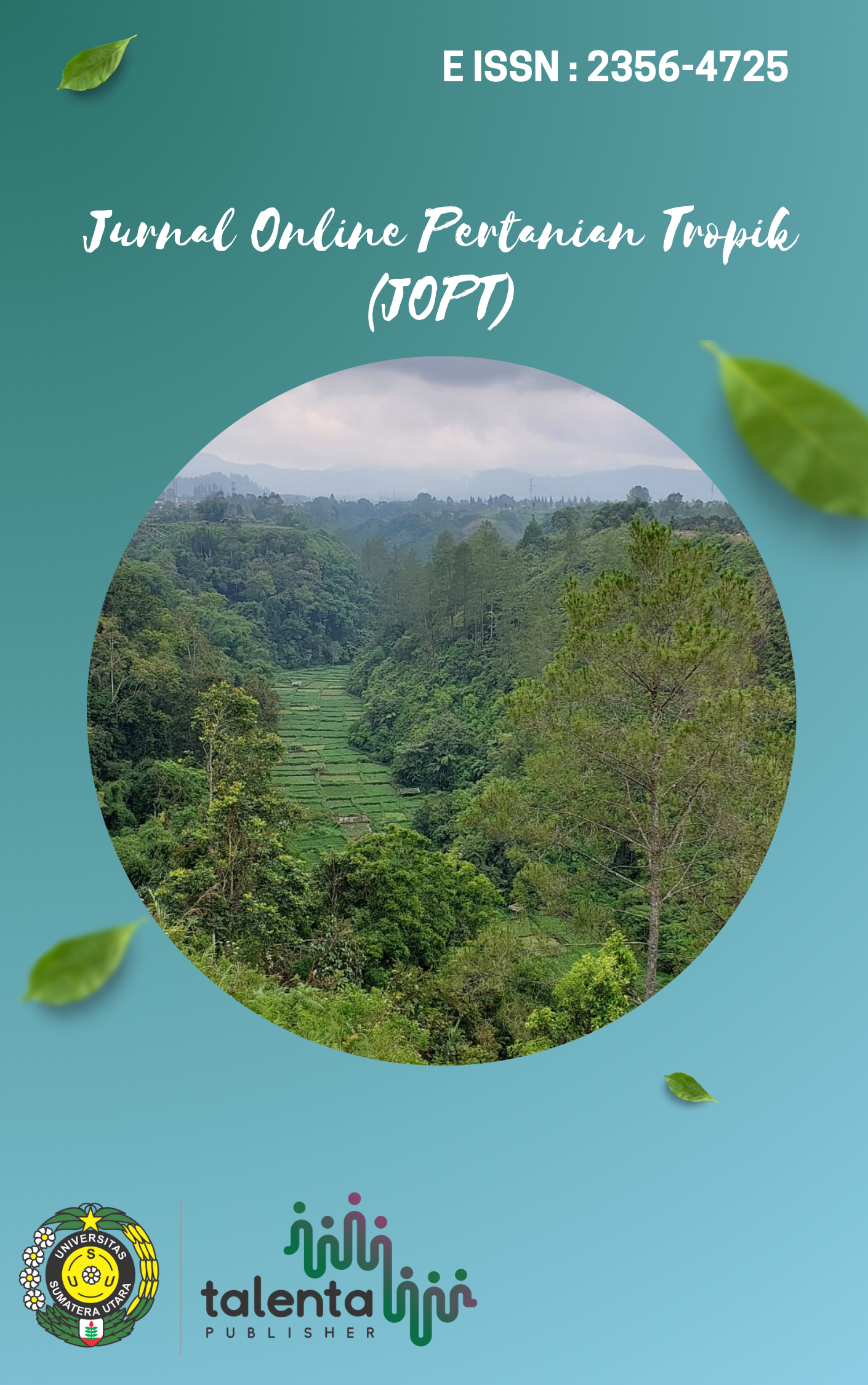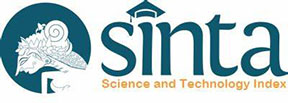Effectiveness of Aromatic Plants on The Population and Intensity of Aphis gossypii Pest Attack on Plant Cucumis sativus
DOI:
https://doi.org/10.32734/jopt.v10i1.8229Keywords:
Pest, Aromatic plants, CucumberAbstract
The control of plant-disturbing organisms particularly in cucumber plant pests, such as the aplications of chemical and vegetable pesticides. The use of chemical pesticides dosis that is determined made the pests more resistent than normal dosis. Reduction of chemical pesticides can be done with a polyculture cropping system using aromatic plants. The purpose of this study was to determine the effect of aromatic plants on population, intensity of pest attacks, and production yields in cucumber plants, then find out the most effective treatment to suppress populations of pest. This research conducted in Tanjung Rejo Village, Wuluhan District, Jember in January to July 2021. The research design used a randomized block design with 4 treatments that is P0 (control), P1 (basil), P2 (leek), and P3 (celery) which is repeated 6 times. The observed variabels were the population of pest, intensity of pest attaks, and cucumber productions. The data obtained were tested with ANOVA and if it were significantly different, further tests were carried out using Duncan Multiple Range Test with a level of 5%. Based on the result of this study, it showed that the types of aromatic plants has an effect on Aphis gossypii pests in cucumber plants with significantly different effects every week. The highest population and intensity of pest damage in P0 (control) treatment is 32,91 tails/ plants and intensity of pest damage is 21,08 %/ plants. The most effective treatment that can suppress the population of pest in basil treatment is 20,48 tails/plant and intensity of pest damage is 15,69 %/plants. The highest cucumber production in the basil treatment is 10,25 tons/Ha and the lowest cucumber production in the control treatment is 8,5 tons/Ha.
Downloads
References
Abdurrazak, M. Hatta, dan A. Marliah. 2013. Pertumbuhan dan Hasil Tanaman Mentimun (Cucumis sativus L.) Akibat Perbedaan Jarak Tanam dan Jumlah Benih Per Lubang Tanam. Agrista, 17(2): 55-59.
Afshari, A., E. S. Negadian, and P. Shishebor. 2009. Population Density and Spatial Distribution of Aphis gossypii Glover (Homoptera: Aphisidae) on Cotton in Gorgan, Iran. Agriculture Sciences Technological, 11(1): 27-38.
Amalina, N. R., Subagiya, dan A. Sulistyo. 2018. Respon Populasi Kutu Daun Persik terhadap Pemberian Beberapa Jenis Ekstrak Kulit Jeruk pada Cabai. Agrosains, 20(1): 13-18.
Anggraini, K., K. A. Yuliadhi, dan D. Widaningsih. 2018. Pengaruh Populasi Kutu Daun pada Tanaman Cabai Besar (Capsicum annuum L.) terhadap Hasil Panen. Agroekoteknologi Tropika, 7(1): 113-121.
Badan Pusat Statistik. 2019. Statistik Hortikultura. Kantor Pusat Statistik Provinsi Jawa Timur. Jawa Timur.
Bouwmeester, H., R. C. Schuurink, P. M. Bleeker, and F. Schiesti. 2019. The Role of Volatiles in Plant Communication. Plant, 100(1): 892-907.
Eliza, T., T. Hasanuddin, dan S. Situmorang. 2013. Perilaku Petani dalam Penggunaan Pestisida Kimia (Kasus Petani Cabai di Pekon Gisting Atas Kecamatan Gisting Kabupaten Tanggamus). JIIA, 1(4): 334-342.
Holopainen, J. K. and J. D. Blande. 2012. Molecular Plant Volatile Communication. Findland: Department of Environmental Science.
Limbanadi, Z., J. M. E. Mamahit, C. L. Salaki, dan G. S. G. Manengkey. 2015. Gejala dan Intensitas Serangan Hama Kutu Daun (Chaetosiphon sp) pada Tanaman Stroberidi Kelurahan Rurukan Kota Tomohon. Pertanian, 1(1): 1-7.
Messakhh, O.S. 2012. Pertumbuhan Tanaman Tomat (Lycopersicum esculentum, Mill) dan Tanaman Sela pada Pola Tanam Monokultur dan Tumpangsari dengan Tanaman Sela Aromatik. Partner, 20(1): 73-86.
Mulyadi, H., B. Nasir, dan M. Yunus. 2017. Pengaruh Tomat dan Kenikir Sebagai Tanaman Repellent Terhadap Plutella xylostella Linn. Agrotekbis, 5(5): 541-546.
Nirmayanti, F., G. Mudjiono, dan S. Karindah. 2017. Pengaruh Beberapa Jenis Tanaman Pendamping terhadap Hama Phyllotreta striolata F. (Coleoptera: Chrysomelidae) pada Budidaya Sawi Hijau Organik. HPT, 2(3): 69-75.
Sudewi, A., A. Ala, Baharuddin, dan M. Farid. 2020. Keragaman Organisme Pengganggu Tanaman (OPT) pada Tanaman Padi Varietas Unggul Baru (VUB) dan Varietas Lokal pada Percobaan Semi Lapangan. Agrikultura, 31(1): 15-24.
Sulianti, S. B. 2008. Studifitkimia Ocimum spp.: Komponen Kimia Minyak Atsiri Kemangi dan Ruku-Ruku. Berita Biologi, 9(3): 237-241.
Utami, N. A. T. A., I. N. Wijaya, I. K. Siadi, I. D. N. Nyana, dan G. Suastika. 2014. Pengaruh Penggunaan Jaring Berwarna terhadap Kelimpahan Serangga Aphis gossypii pada Tanaman Cabai Rawit (Capsicum frutescens L.). Agroteknologi Tropika, 3(4): 251-258.
Widiyastuti, Y., L. Widowati, Y. Bahar, dan U. Siswanto. 2021. Seledri (Apium graveolens L.): Tanaman Aromatik Melawan Hipertensi. Jakarta: Lipi Press.
Wonorahardjo, S., Nurindah, D. A. Sunarto, Sujak, dan N. Zakia. 2015. Analisis Senyawa Volatil dari Ekstrak Tanaman yang Berpotensi sebagai Atraktan Parasitoid Telur Wereng Batang Coklat, Anagrus nilaparvatae (Pang et Wang) (Hymenoptera: Mymaridae). Entomologi Indonesia, 12(1): 48-57.
Yarou, B. B., A. H. B. Ganta, F. J. Verheggen, G. C. Lognay, and F. Francis. 2020. Aphis Behavior on Amaranthus hybridus L. (Amaranthaceae) Associated with Ocimum spp. (Lamiaceae) as Repellent Plants. Agronomy, 10(1): 1-10.
Downloads
Published
How to Cite
Issue
Section
License
Copyright (c) 2023 Jurnal Pertanian Tropik

This work is licensed under a Creative Commons Attribution-ShareAlike 4.0 International License.






















